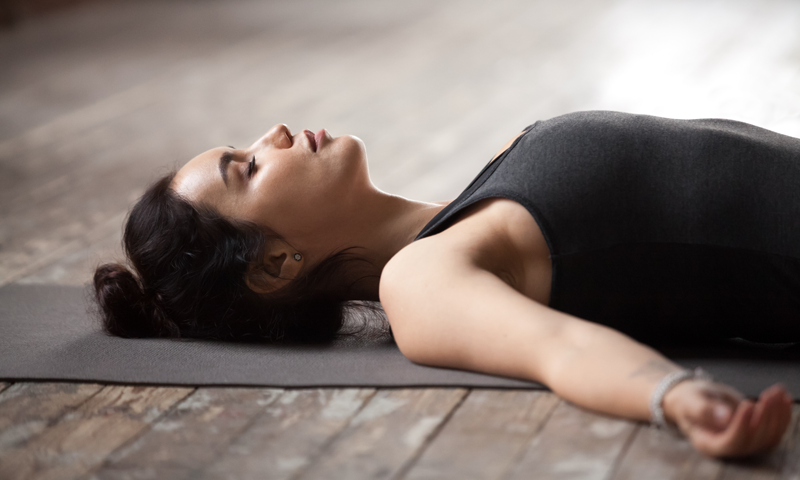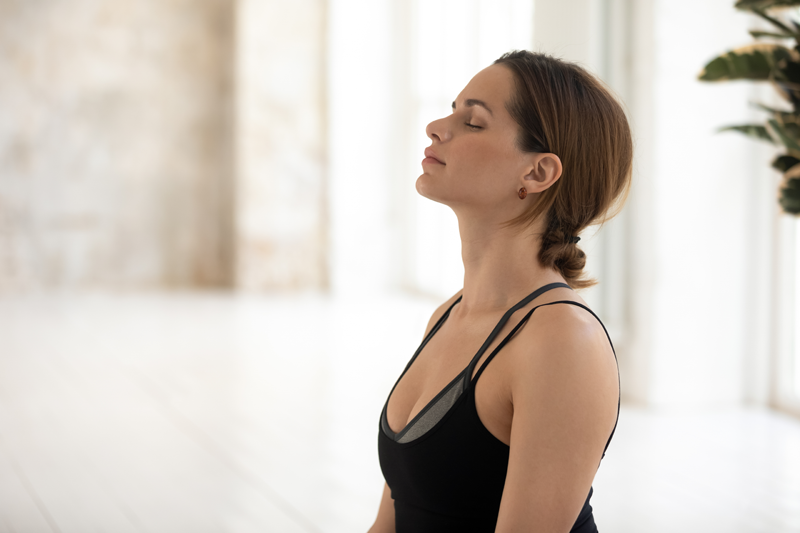
7 Things Yoga Taught Me About Women
7th February 2020
Why is Yoga Needed in All Communities?
14th February 2020This Simple 30-second Practice Helps Relieve Anxiety

Anxiety is awful. It can creep up on us without warning and get in the way of day to day life. While some people find medication helpful, others prefer to use natural alternatives. Thankfully, yoga is one of the best ways to reduce anxiety naturally, with various asanas, pranayamas and meditation practices helping to relieve symptoms. In this article, we focus on one particular breathing exercise known as Mindful Pause. This simple 30-second practice helps relieve anxiety.
The technique is great for times when you’re feeling anxious, stressed or overwhelmed. Better still, it can be practised anywhere and takes as little as 30 seconds. You can be standing, sitting or lying down – depending on which is most comfortable for you. There’s no need to put on your yoga bra either, so no one will even know you’re meditating.
What is the Mindful Pause?
Mindful Pause is a tool that every yogi can use at one time or another, whether it’s in the workplace or to calm your racing mind at home. As you can practice Mindful Pause in just 30 seconds, it doesn’t get in the way of day to day life and you can practice it at any place, at any time. A recent study showed that using Mindful Pause for 30 seconds per day reduced symptoms of anxiety and improved focus and energy levels. Not only that, but it can have lifelong changes to your mental health, helping you to see the bigger picture when you feel anxious, stressed or irritated. Participants of the study found that when they didn’t practice Mindful Pause, they found themselves more easily anxious, stressed and confused.
The Four Steps of the Mindful Pause
Below, we explore the four steps of Mindful Pause so you can use it to reduce anxiety.
1. Deep Breath
The first thing to do is take a deep, slow breath to fill your lungs from bottom to top. Breath air into your lower abdomen before filling upward through your torso and chest. This simple breathing practice takes advantage of the connection between our breath and mood. By slowing and deepening the breathing, we encourage feelings of calm and relaxation.
2. Turn Inward
Next, turn your attention inward and focus on the sensations in your body. Notice whatever feelings come up, whether that be coolness, warmth, pressure or tingling. Also, notice the touch of clothing and how it feels on your body. As the sensations arise, try not to evaluate them as good or bad. Instead, simply let them be. If you notice a wide array of sensations – great. If all you notice is the feeling of your clothes on your body, that’s fine too. If you notice feelings that are connected to anxiety or stress, turn inward and focus your attention on them. Naturally, we often pull away from these sensations and perceive them as negative. Unfortunately, this resistance creates suffering and can make things worse in the long run. To avoid this, notice the sensations as they arise and focus on them without evaluating. If you’re strapped for time, this step doesn’t need to take longer than one breath. However, you can practice for longer if you so wish.

3. Focus on Your Breath
Next, notice the sensation of air entering your body as you breathe. Notice the changing sensations in your nostrils as the air comes in and out. These sensations will help you to stay in the present moment. In this step, there’s no need to slow and deepen your breath. Instead, let your body breathe naturally. Just like step 2, this step can be as short as one breath if necessary. However, you may feel like staying in it for longer – it’s totally up to you.
4. Carry On
The final step is to reengage with the world, without rushing yourself. If you’ve had your eyes closed, open them and carry on with your day. As you go about your life, see if you can maintain the calmness that you’ve cultivated. If possible, try to reengage with the world slowly instead of speeding off to your next activity. Take a few seconds to sit quietly before carrying on at a gentle pace.
The Benefits of the Mindful Pause
There are many benefits of Mindful Pause. Firstly, it interrupts thought loops and emotional spirals to stop you from spinning out. When you’re having an anxiety attack, sometimes you need to interrupt your thought process. Mindful Pause allows you to break the spiral and collect yourself.
Mindful Pause also encourages you to turn inward to discomfort, rather than pulling away from it. When we feel an unpleasant emotion like fear or anxiety, we naturally try to escape it. We fight the emotion, try to avoid it or try to problem-solve our way out. Unfortunately, these techniques can agitate us further. Instead of fighting the difficult emotions, turn inward and really feel them. We can do this by paying attention to the sensations in our body as they arise. Emotions often come with a strong physical component, such as a tightness in the chest, twisting in the gut, or warmth in the face. This sensation varies from person to person and is different from moment to moment. Staying with these sensations instead of running away from them can help us to overcome the anxiety. This teaches us that suffering doesn’t come from our emotions but our evaluations of them or resistance to them. When we learn to meet the emotions without resistance, they become far less problematic in day to day life.
In Summary
If you want to reduce symptoms of anxiety, practice Mindful Pause. This simple 30-second practice helps relieve anxiety. If you’re struggling to focus, invest in some yoga jewellery. Many people find that a small, single-toned flute worn around the neck helps to quiet the mind.

